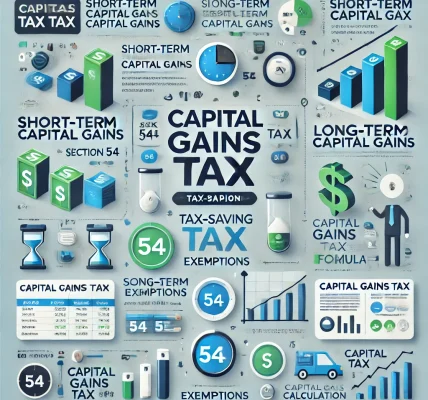Taxation is an essential aspect of personal finance, and understanding how tax brackets and slabs work can help individuals make informed financial decisions. In many countries, including India and the U.S., governments use a progressive tax system, meaning the more you earn, the higher the percentage of tax you pay. However, tax brackets and slabs ensure that only income within a specific range is taxed at a particular rate, not the entire income.
If you’re new to tax planning, this guide will walk you through the concept of tax brackets, how they work, and how you can optimize your tax liability by using exemptions and deductions.
1. What Are Tax Brackets and Slabs?
A tax bracket refers to a range of income taxed at a particular rate. Taxpayers are divided into different income groups (slabs), each with a different tax rate. The more you earn, the higher the percentage of tax you pay on the portion of income falling within that slab.
For example, if there are three tax brackets:
- Up to $10,000: 10% tax
- $10,001 – $50,000: 20% tax
- Above $50,000: 30% tax
It does NOT mean that if you earn $60,000, your entire income is taxed at 30%. Instead:
- The first $10,000 is taxed at 10%.
- The next $40,000 is taxed at 20%.
- The remaining $10,000 is taxed at 30%.
This system ensures fairness so that higher earners do not lose too much income to taxation.
2. How Tax Slabs Work in India (For Financial Year 2023-24)
In India, taxpayers can choose between two tax regimes:
- Old Tax Regime (With deductions & exemptions)
- New Tax Regime (Lower tax rates but without deductions & exemptions)
Old Tax Regime (With Deductions)
| Income Slab (₹) | Tax Rate |
|---|---|
| Up to 2,50,000 | No Tax |
| 2,50,001 – 5,00,000 | 5% |
| 5,00,001 – 10,00,000 | 20% |
| Above 10,00,000 | 30% |
New Tax Regime (Without Deductions)
| Income Slab (₹) | Tax Rate |
| Up to 2,50,000 | No Tax |
| 2,50,001 – 5,00,000 | 5% |
| 5,00,001 – 7,50,000 | 10% |
| 7,50,001 – 10,00,000 | 15% |
| 10,00,001 – 12,50,000 | 20% |
| 12,50,001 – 15,00,000 | 25% |
| Above 15,00,000 | 30% |
Note: Individuals earning up to ₹5,00,000 under both regimes get a rebate under Section 87A, making them tax-free.
3. How Tax Slabs Work in the U.S. (For 2023-24 Tax Year)
In the U.S., federal income tax is also progressive and divided into seven tax brackets based on filing status (Single, Married Filing Jointly, etc.).
U.S. Federal Tax Brackets for Single Filers (2023-24)
| Income Bracket ($) | Tax Rate |
| Up to 11,000 | 10% |
| 11,001 – 44,725 | 12% |
| 44,726 – 95,375 | 22% |
| 95,376 – 182,100 | 24% |
| 182,101 – 231,250 | 32% |
| 231,251 – 578,125 | 35% |
| Above 578,125 | 37% |
For married individuals, different thresholds apply, but the progressive nature remains the same.
4. How to Reduce Your Tax Liability?
A. Choose the Right Tax Regime (For Indian Taxpayers)
- If you have high deductions (80C, HRA, medical insurance, home loan interest, etc.), the Old Regime is more beneficial.
- If you have few or no deductions, the New Regime provides lower tax rates.
B. Utilize Deductions and Exemptions (For Global Taxpayers)
- Section 80C (India): Investments like PPF, ELSS, Life Insurance, and EPF allow deductions up to ₹1.5 lakh.
- Standard Deduction (India & U.S.): Fixed deduction for salaried individuals and pensioners.
- 401(k) Contributions (U.S.): Pre-tax retirement savings reduce taxable income.
- Health Insurance (80D in India, HSA in the U.S.): Deductions for health insurance premiums.
C. Invest in Tax-Efficient Instruments
- Tax-free bonds, municipal bonds, and certain long-term capital gains exemptions.
- Retirement savings plans such as NPS (India) and Roth IRA (U.S.).
D. Claim HRA and Rent Deductions
- House Rent Allowance (HRA) is exempt under the old tax regime in India.
- U.S. taxpayers can claim mortgage interest deductions if they own a home.
5. Common Mistakes to Avoid While Filing Taxes
- Not declaring all sources of income: Interest from savings, fixed deposits, and capital gains should be reported.
- Choosing the wrong tax regime (India): Analyze tax savings before opting for a regime.
- Ignoring tax-saving investments: Utilize all available deductions to reduce taxable income.
- Filing taxes late: Penalties apply for delayed tax filings.
- Not verifying tax returns: Ensure accuracy before submission to avoid issues.
Final Thoughts
Understanding tax brackets and slabs is crucial for effective tax planning. By knowing how your income is taxed and utilizing available deductions, you can legally minimize your tax liability. Whether you’re in India, the U.S., or another country, the fundamental principle remains the same: higher income is taxed at higher rates, but strategic planning can help reduce your tax burden.
Before making any tax-related decisions, consult a certified tax professional to ensure compliance with the latest tax laws. Smart tax planning today can lead to better financial health tomorrow!Taxation is an essential aspect of personal finance, and understanding how tax brackets and slabs work can help individuals make informed financial decisions. In many countries, including India and the U.S., governments use a progressive tax system, meaning the more you earn, the higher the percentage of tax you pay. However, tax brackets and slabs ensure that only income within a specific range is taxed at a particular rate, not the entire income.
If you’re new to tax planning, this guide will walk you through the concept of tax brackets, how they work, and how you can optimize your tax liability by using exemptions and deductions.
1. What Are Tax Brackets and Slabs?
A tax bracket refers to a range of income taxed at a particular rate. Taxpayers are divided into different income groups (slabs), each with a different tax rate. The more you earn, the higher the percentage of tax you pay on the portion of income falling within that slab.
For example, if there are three tax brackets:
- Up to $10,000: 10% tax
- $10,001 – $50,000: 20% tax
- Above $50,000: 30% tax
It does NOT mean that if you earn $60,000, your entire income is taxed at 30%. Instead:
- The first $10,000 is taxed at 10%.
- The next $40,000 is taxed at 20%.
- The remaining $10,000 is taxed at 30%.
This system ensures fairness so that higher earners do not lose too much income to taxation.
2. How Tax Slabs Work in India (For Financial Year 2023-24)
In India, taxpayers can choose between two tax regimes:
- Old Tax Regime (With deductions & exemptions)
- New Tax Regime (Lower tax rates but without deductions & exemptions)
Old Tax Regime (With Deductions)
| Income Slab (₹) | Tax Rate |
|---|---|
| Up to 2,50,000 | No Tax |
| 2,50,001 – 5,00,000 | 5% |
| 5,00,001 – 10,00,000 | 20% |
| Above 10,00,000 | 30% |
New Tax Regime (Without Deductions)
| Income Slab (₹) | Tax Rate |
| Up to 2,50,000 | No Tax |
| 2,50,001 – 5,00,000 | 5% |
| 5,00,001 – 7,50,000 | 10% |
| 7,50,001 – 10,00,000 | 15% |
| 10,00,001 – 12,50,000 | 20% |
| 12,50,001 – 15,00,000 | 25% |
| Above 15,00,000 | 30% |
Note: Individuals earning up to ₹5,00,000 under both regimes get a rebate under Section 87A, making them tax-free.
3. How Tax Slabs Work in the U.S. (For 2023-24 Tax Year)
In the U.S., federal income tax is also progressive and divided into seven tax brackets based on filing status (Single, Married Filing Jointly, etc.).
U.S. Federal Tax Brackets for Single Filers (2023-24)
| Income Bracket ($) | Tax Rate |
| Up to 11,000 | 10% |
| 11,001 – 44,725 | 12% |
| 44,726 – 95,375 | 22% |
| 95,376 – 182,100 | 24% |
| 182,101 – 231,250 | 32% |
| 231,251 – 578,125 | 35% |
| Above 578,125 | 37% |
For married individuals, different thresholds apply, but the progressive nature remains the same.
4. How to Reduce Your Tax Liability?
A. Choose the Right Tax Regime (For Indian Taxpayers)
- If you have high deductions (80C, HRA, medical insurance, home loan interest, etc.), the Old Regime is more beneficial.
- If you have few or no deductions, the New Regime provides lower tax rates.
B. Utilize Deductions and Exemptions (For Global Taxpayers)
- Section 80C (India): Investments like PPF, ELSS, Life Insurance, and EPF allow deductions up to ₹1.5 lakh.
- Standard Deduction (India & U.S.): Fixed deduction for salaried individuals and pensioners.
- 401(k) Contributions (U.S.): Pre-tax retirement savings reduce taxable income.
- Health Insurance (80D in India, HSA in the U.S.): Deductions for health insurance premiums.
C. Invest in Tax-Efficient Instruments
- Tax-free bonds, municipal bonds, and certain long-term capital gains exemptions.
- Retirement savings plans such as NPS (India) and Roth IRA (U.S.).
D. Claim HRA and Rent Deductions
- House Rent Allowance (HRA) is exempt under the old tax regime in India.
- U.S. taxpayers can claim mortgage interest deductions if they own a home.
5. Common Mistakes to Avoid While Filing Taxes
- Not declaring all sources of income: Interest from savings, fixed deposits, and capital gains should be reported.
- Choosing the wrong tax regime (India): Analyze tax savings before opting for a regime.
- Ignoring tax-saving investments: Utilize all available deductions to reduce taxable income.
- Filing taxes late: Penalties apply for delayed tax filings.
- Not verifying tax returns: Ensure accuracy before submission to avoid issues.
Final Thoughts
Understanding tax brackets and slabs is crucial for effective tax planning. By knowing how your income is taxed and utilizing available deductions, you can legally minimize your tax liability. Whether you’re in India, the U.S., or another country, the fundamental principle remains the same: higher income is taxed at higher rates, but strategic planning can help reduce your tax burden.
Before making any tax-related decisions, consult a certified tax professional to ensure compliance with the latest tax laws. Smart tax planning today can lead to better financial health tomorrow!




